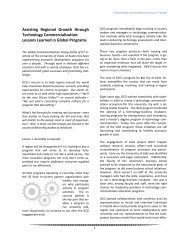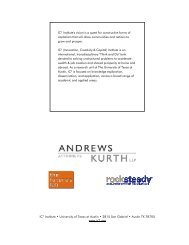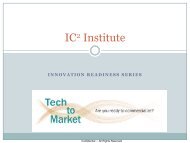“Quicklook” Assessment of Greater Adelaide's Assets & Challenges ...
“Quicklook” Assessment of Greater Adelaide's Assets & Challenges ...
“Quicklook” Assessment of Greater Adelaide's Assets & Challenges ...
Create successful ePaper yourself
Turn your PDF publications into a flip-book with our unique Google optimized e-Paper software.
• Transfer the cooperative model <strong>of</strong> wine to other industries, such as fish, dairy,<br />
olive processing and Information Technology industries. Teach them how to be<br />
less fragmented and more focused on global exports.<br />
• Work with other industry employers as they recruit talented people from all over<br />
the globe to make the presence <strong>of</strong> the wine industry another lifestyle “plus” for<br />
South Australia.<br />
• Increase benefits from wine tourism to the wineries themselves through increased<br />
cooperation between the tourism operators and State Tourism authorities. Wine<br />
tourism is expected to double in the next 10 years.<br />
Case Studies<br />
• Australian companies by nature understand exporting better than companies in<br />
other countries. Now the muscle developed by successful exporters is being seen<br />
in acquisitions such as that <strong>of</strong> Beringer Wine Estates by Foster’s Brewing Group<br />
Ltd.<br />
• The Mutual Acceptance Agreement on Oenological Practices <strong>of</strong> the New World<br />
Wine Producers Forum was agreed to in principle in the spring <strong>of</strong> 2001. When the<br />
agreement is completely negotiated and signed, it will mean that a signatory<br />
country cannot refuse to accept a wine from another signatory country that has<br />
been made in accordance with the oenological practices <strong>of</strong> the importing country.<br />
Australia has been a leader and proponent <strong>of</strong> the agreement as a means <strong>of</strong><br />
protecting its overseas wine trade.<br />
• The South Australian wine industry is a leader in technology transfer. Frameworks<br />
such as the Grape and Wine Research and Development Corporation provide<br />
growers and processors many tools including facilitation <strong>of</strong> coinvestment and<br />
development <strong>of</strong> training programs that enhance the long-term development and<br />
competitiveness <strong>of</strong> the industry.<br />
Facilitators<br />
Resources<br />
• The industry has been successful in getting enough hectares under cultivation to<br />
meet aggressive targets for supply in the past. The 2010 and 2025 targets appear<br />
to be achievable.<br />
• The ports <strong>of</strong> South Australia with their plans for expansion are sufficient to handle<br />
the increased throughput for the future. A specialized facility for the shipping <strong>of</strong><br />
wine is currently being constructed.<br />
• Availability <strong>of</strong> skilled workers appears sufficient to achieve the 2% annual growth<br />
rate projected.<br />
• Worldwide demand for quality wines is increasing. While declining consumption<br />
trends in traditional wine producing countries such as France, Italy and Argentina<br />
will have an effect, growing consumer markets in the UK, Scandinavia and North<br />
America, as well as Asia, South America and Africa are areas for which the<br />
Australian wine industry is well positioned to serve.<br />
Business Processes<br />
• The industry’s Marketing Decade plans for helping achieve higher average<br />
margins and enhanced brand values for Australian wine.<br />
COMMERCIAL IN CONFIDENCE<br />
127





